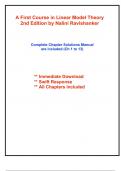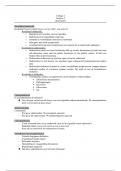A First Course in Linear Model Theory
2nd Edition by Nalini Ravishanker
Complete Chapter Solutions Manual
are included (Ch 1 to 13)
** Immediate Download
** Swift Response
** All Chapters included
,Solutions to Chapter 1
√ √
1.1 |a • b| = | − 9| = 9, while kak kbk = 6 22 ∼
= 11.489 > 9.
1.2 To verify the Cauchy–Schwarz inequality, first see that the inequality holds trivially if
a and b are zero vectors. We therefore assume that both a and b are nonzero. Let c be
the vector c = xa − yb, where x = b0 b, and y = a0 b. Clearly, c0 c ≥ 0. We express c0 c
in terms of x and y:
c0 c = (xa − yb)0 (xa − yb) = x2 a0 a − 2xya0 b + y 2 b0 b.
Since c0 c ≥ 0, and using the definitions of x and y, we see that
(b0 b)2 (a0 a) − 2(a0 b)2 (b0 b) + (a0 b)2 (b0 b) ≥ 0
and dividing by b0 b in the last inequality, we see that
(b0 b)(a0 a) − (a0 b)2 ≥ 0,
which verifies the Cauchy–Schwarz inequality.
We use the Cauchy–Schwarz inequality to deduce the triangle inequality, which can be
written in an equivalent form
ka + bk2 ≤ (kak + kbk)2 .
The expression on the left is
ka + bk2 = (a + b) • (a + b) = a • a + 2a • b + b • b
= kak2 + 2a • b + kbk2
while the expression on the right is
(kak + kbk)2 = kak2 + 2kakkbk + kbk2 .
Comparing these two formulas, we see that the triangle inequality holds if and only
if a • b ≤ kak kbk. By Cauchy–Schwarz inequality, |a • b| ≤ kakkbk, so the triangle
inequality follows as a consequence of the Cauchy–Schwarz inequality. The converse is
also true; i.e., if the triangle inequality holds, then a • b ≤ kakkbk holds for a and for −a,
from which Cauchy–Schwarz inequality follows. If equality holds, i.e., if a • b = kakkbk,
then b = ca, for some scalar c. Hence, a • b = ckak2 , and kakkbk = |c|kak2 . For nonnull
a, this implies that c = |c|, so that c ≥ 0. If b 6= 0, then b = ca, with c > 0.
1.3 Since x0 y = 0 = x0 z = y0 z, it follows that we must
√ solve the equations
√ a2 + b2 = 1, and
2 2
a − b = 0, for which the solutions are a = ±1/ 2 and b = ±1/ 2.
1.4 Let
1 2 0
1 0 −2
V=
0
.
1 1
−1 −1 1
1
, 2 Solutions to Chapter 1
Using elementary column transformations C2 − 2C1 , and then, C3 − C2 , the matrix V
becomes
1 0 0
1 −2 0
V= 0
,
1 0
−1 −1 0
so that the column rank of V (or the dimension of its column space) is 2 < 3. Therefore,
v1 , v2 and v3 are linearly dependent. It is easily seen that v1 and v2 are LIN, and that
v3 = v2 − 2v1 .
1.5 It is easy to see that c1 v1 + c2 v2 + c3 v3 = 0 results in the following three equations,
and the only solution is c1 = 0, c2 = 0, and c3 = 0:
2c1 + 8c2 − 4c3 = 0
3c1 − 6c2 + 3c3 = 0
2c1 + 5c2 + c3 = 0.
1.6 Using elementary transformations, we can show that A is equivalent to the matrix
−3 3 3
0 4 4 ,
0 0 −1
so that the columns of A are LIN.
� � � � � �
2 1 3
1.7 We can solve the system = c1 + c2 to get c1 = −1 and c2 = 1. Hence, u
3 2 5
is in Span{v1 , v2 }.
· · · , vm are linearly dependent, then there are scalars c1 , · · · , cm not
1.8 If v1 ,P Pall zero, such
m
that i=1 c i vi = 0. For any k with ck 6
= 0, we then have v k = − i6=k (ci /ck )vi ,
showing property 1 in Result 1.2.2.
Suppose without loss of generality that Pvs 1 , · · · , vs are linearly dependent and c1 , · · · , cs
are constants, not all zero, such that P i=1 ci vi = 0. Let cj = 0 for all j = s + 1, · · · , n.
n
Then c1 , · · · , cn are not all zero and i=1 ci vi = 0. Hence v1 , · · · , vn are linearly
dependent, showing property 2 in Result 1.2.2.
1.9 1. Let S = {v1 , · · · , vn } denote a set of nonzero orthogonal vectors, and let u belong to
the span of S with
u = c1 v1 + · · · + cn vn .
For a fixed i = 1, · · · , n, take the inner product of each side with vi . Since vi • vj = 0,
i 6= j,
u • vi = c1 (v1 • vi ) + · · · + cn (vn • vi ) = ci (vi • vi ).
�
Hence, ci = (u • vi ) (vi • vi ). To verify linear independence, set u = c1 v1 +· · ·+cn vn = 0.
This implies that ci = 0, i = 1, · · · , n, which in turn implies LIN of {v1 , · · · , vn }.





